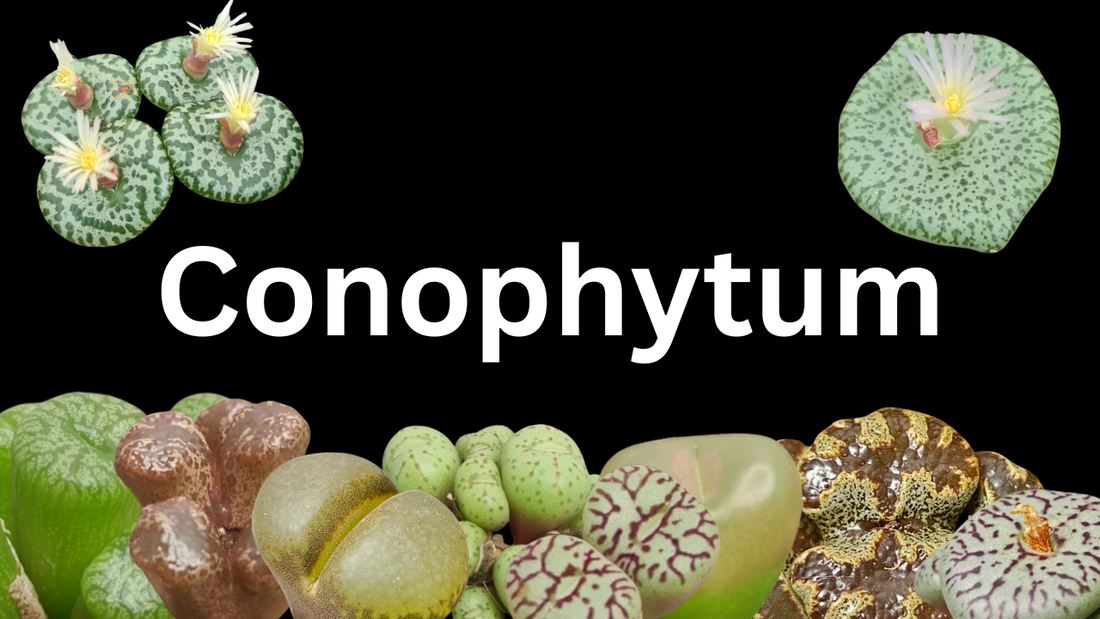
How to grow Conophytum
How to Grow Conophytum — The Tiny Winter-Blooming Wonders
By Cori White, Spine City Cacti & Succulent Nursery
If you're looking for succulents that stay small, stand out, and thrive in the colder months, Conophytum might just be your new favorite. These miniature marvels are true collectors' plants—gorgeous, eccentric, and surprisingly resilient once you understand their rhythm.
At Spine City, we’ve spent years growing and studying these plants. This complete guide is based on our hands-on experience and will walk you through everything from watering to substrate to seasonal quirks.
What Are Conophytum?
Conophytum are true miniatures. They never grow large or sprawling, making them the ideal choice if space is tight. Despite their size, they add massive charm—especially during winter, when most other succulents are dormant or dull.
They come in an incredibly broad range of forms, colors, and patterns. Some look like pebbles, some like candy, and all of them feel like little botanical treasures.
The Seasonal Cycle: Sheaths, Shrivels & Surprises
Conophytum are winter growers. Understanding their cycle is key:
- Late Summer to Early Winter: Active growth begins.
- Mid-Winter: A slight pause, then another flush of growth.
- Spring to Early Summer: Plants prepare for dormancy.
- Summer: Full dormancy begins.
During dormancy, they form a papery sheath—a natural adaptation to protect against summer heat and dryness. They will look shriveled and lifeless. Don’t panic—this is completely normal.
Awakening: When the Magic Begins
From late summer to mid-autumn, Conophytum start waking up—often even without water.
Watering During Awakening
- Start very lightly. A gentle "psst psst" with a spray bottle every 7–10 days is perfect.
- After a few weeks, roots re-engage, and the plant starts plumping up.
- Once you're sure it's growing, increase water volume—but not frequency.
They’re highly efficient water users. Most growers can get away with spray bottle watering only for the entire season. Full saturation of the pot should happen just a few times in peak growing season.
Watering Guide by Season
🪴 Late Summer to Early Winter
Light to moderate watering every 7–10 days.
❄️ Dead of Winter
Water less: every 10–14 days with a smaller amount.
🌸 Late Winter to Early Spring
Increase volume again every 7–10 days to prep for dormancy.
☀️ Summer
Stop watering entirely once plants are fully husked. If you must water, do so every 3–5 weeks max—lightly and cautiously.
Reading Your Plants
Conophytum are expressive. If they look full and juicy, skip the water. If they look dull despite following the schedule, give them a bit more.
Overwatering?
You might see splitting—not ideal, but not fatal. They’ll likely recover, though you may see a scar until next season’s growth hides it.
Soil & Substrate: The Backbone of Success
You’ve probably noticed in our photos: lots of gravel, there is no “top dressing.” That’s not an accident.
We use a 100% mineral mix with just a pinch of bark - a few small pieces per pot.
Substrate Must-Haves:
- High drainage: Minimum 75% gravel or mineral.
- Fine to small particle size: Avoid large chunks.
- Low organics: Too much potting mix = bloated, weak plants.

Where to source?
Aquarium shops are great for fine quartz pebbles. Sand can work in small amounts. Just avoid heavy, root-smothering mixes.
Light Requirements
Conophytum prefer moderate to strong light—but not scorching sun. Indoors is not suitable.
In summer, move dormant plants to a sheltered spot. Make sure they stay dry—moisture can cause them to wake too early.

Fertiliser: Keep It Simple
Twice per year is all they need:
- First dose: When they’ve fully woken after summer.
- Second dose: After the coldest part of winter.
Use a general-purpose soluble fertiliser at half strength.
Quick Reference Guide
Water:
- Late summer to early winter: 7–10 days, light to moderate
- Dead of winter: 10–14 days, light
- Late winter to early spring: 7–10 days, moderate
- Summer: None (or once every 3–5 weeks, extremely light)
Light:
- Moderate to strong
- Protect from summer extremes
- Not suitable for indoor growing
Substrate:
- Free-draining
- 75–100% gravel/mineral
- Low organics, fine particle size
Fertiliser:
- Half-strength, twice per growing season (autumn and spring)

Final Thoughts
Yes, growing guides can be overwhelming—especially with quirky plants like Conophytum. You’ll eventually find yourself giving one an extra drop of water or rotating another slightly for just the right light. That’s all part of the magic.
These plants are not difficult. They’re adaptable, forgiving, and a joy to grow once you fall into rhythm with them.

🛒 Where to Get Them
You can shop Conophytum on our webstore.
- Confirmed varieties
- Mixed selections for those who love surprises
Want to explore more? Head to the Grow with Spine City blog or browse the FAQ.
🙏 Thanks for Reading
Hope you’ve enjoyed this peek into these incredible plants.
We’ll share more stories soon.
💚 Support Our Work
Our guides and blog posts are free to read, ad-free, and no login required.
If you’ve found them helpful, feel free to:
Every little bit helps us keep growing 🌵
Best wishes and Happy Gardening
— Cori
Spine City Cacti & Succulent Nursery